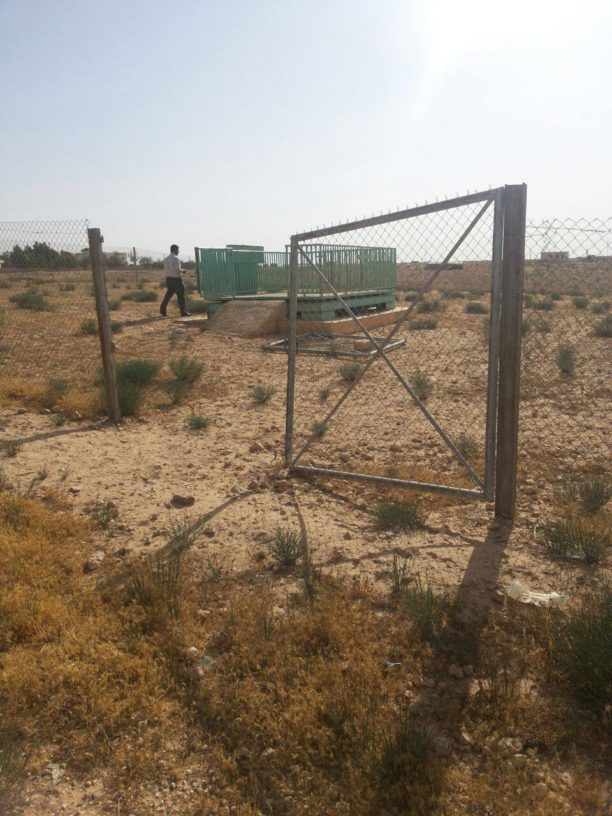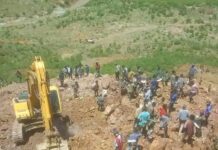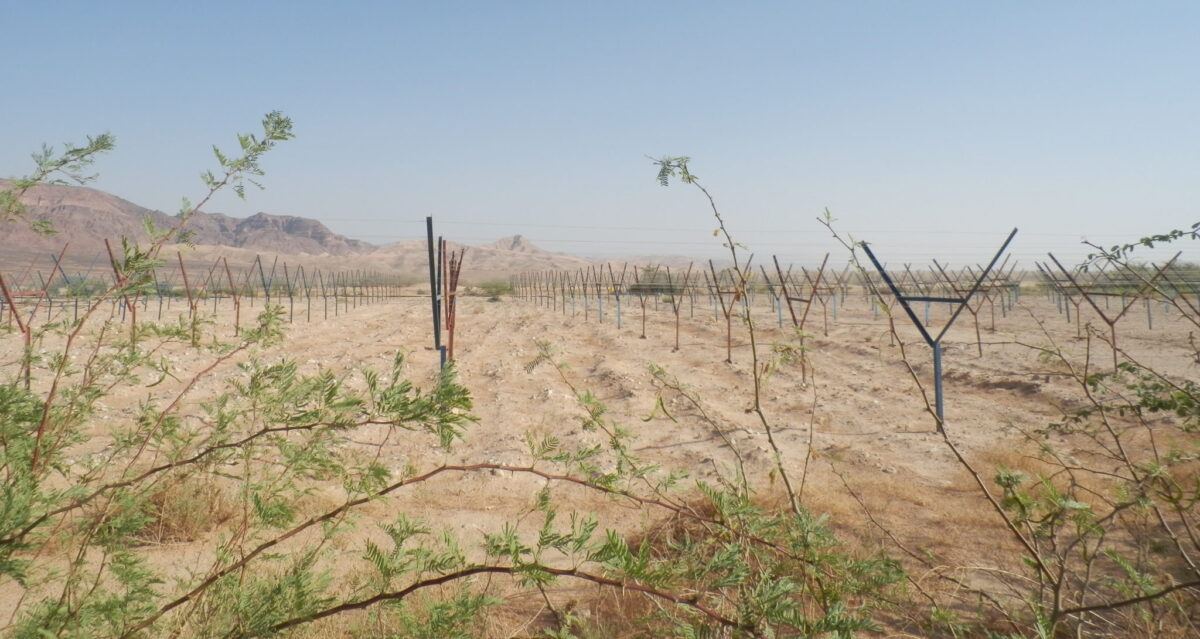by Majdoleen Hasan and Moath Freihat
ABOUT AN HOUR'S DRIVE SOUTH OF AMMAN, JORDAN...
on a spare farm in one of the country’s poorest regions, wire cages stood empty and rusted water troughs sat upturned and useless. A tattered sign blew in the desert wind. This was the only evidence that an ostrich farm had once operated here, built up by a charitable foundation chaired by the country’s royal family, and started with a grant from the United States government.
The farm was supposed to provide a livelihood for people in the hardscrabble Um ar-Rassas region.
But the ostriches supplied by project managers were a crossbreed, ill-suited to the harsh desert conditions and sold to the farm at a price far too high to make the project profitable, said Ahmedi Shahban, head of the Ostrich Association in Um ar-Rassas.
“The project is useless. Every week, two to three ostriches died,” a despondent Shahban said.
The farm closed in 2007 after most of the birds died. But the failure did not keep Queen Rania Al Abdullah’s website from praising the farm in 2007, calling it an example of sustainable agriculture. The Queen heads the Jordan River Foundation, which had designed and implemented the $500,000 project. Her website said it generated $60,000 in revenue a year for the community – money that Shahban said he has never seen.
In the southern Jordan River Valley, an unemployed farm worker told a similar story of broken promises. Forty-year old Ahmad Al-Ja’arat sat on a worn-out mattress in a two-room house, his 12 children gathered around him. He spoke in fractured sentences, despair and anger in his voice, of how he lost his job growing black pepper, tomatoes and eggplants on a government-sponsored farming project that opened in 2007.
The manager of that farm rarely turned up, hired under-age workers and demanded 12-hour work shifts in the baking sun without providing access to drinking water, Al-Ja’arat said. Queen Rania visited the farm with a TV crew in 2009. Al-Ja’arat said that when he tried to tell the Queen about working conditions there, the farming cooperative officials silenced him, and then fired him.
“I have nothing to pay my rent,” Al-Ja’arat said. “How can I work? Where can I possibly go with my children? Does Her Majesty know what is happening here?”
The ill-fated ostrich and vegetable ventures, and the frustrated hopes of Shahban and Al-Ja’rat, are emblematic of a larger development failure in Jordan. The United States has poured over $1 billion into projects in the country since the attacks of September 11 — projects intended to create economic opportunities in impoverished regions and counter the appeal of terrorism.
President Trump has generally derided foreign aid as a drain on US taxpayers. As he seeks to rally Muslim nations in the fight against terrorism during his current trip to the region, such projects could be an important balance to military and security cooperation that the Trump administration has favored. The record in Jordan, however, suggests that development aid, in the absence of oversight, ultimately fueled the very frustrations it sought to calm.
In the months after 9/11, Jordan, a long-time ally of the United States in the Middle East, seemed like a promising place to flex soft power through development aid. During a 2002 visit to Washington, DC, King Abdullah bin al Hussein won U.S. backing for a Jordanian government plan to help fund an $817 million program that he said would lift up impoverished communities in Jordan, provide jobs and address the roots of terrorism, a program that Jordan continues funding to this day.
However, an investigation by 100Reporters has found a pattern of questionable projects, poor management and an absence of accountability. The findings include:
Out of 10 development projects chosen at random from a government list of 136 active projects...
four had closed down and two were never finished. Four others have yet to generate the promised jobs or profits.
Contracts for the 10 projects were awarded exclusively to four national charities...
three of which have ties to Jordan’s royal family. They have operated with little oversight.
The Jordanian government bypassed competitive bidding in awarding the projects to the charities...
with poor records of project management.
Unsuccessful management of past projects.
FREQUENT FAILURE
Across Jordan, USAID and others have supported a variety of development efforts, from almond groves to ostriches. Click on the icons to see what happened.
“Terrorism really flourishes in areas of poverty, despair and hopelessness, where people see no future. We have to show people who might move in the direction of terrorism that there is a better way,” U.S. Secretary of State Colin Powell said in 2002.
The better way could have been an artisans’ market in Jordan’s Madaba region, a tourist magnet southwest of Amman, famous for its mosaic tile. But reporters in April 2015 found no trace of how its managers spent $500,000 that had been invested in the project. The Jordan Hashemite Foundation for Human Development, chaired by Princess Basma, the sister of the late King Hussein, was responsible for the project and did not respond to queries. It worked in partnership with Creative Associates International, a Washington DC-based non-governmental organization (NGO) that works in 85 countries. The organization declined to comment, explaining that it would be difficult to track down records for a project started a decade ago.
Another $500,000 was invested in almond trees in Theban, a depressed community where about one fourth of the 56,000 residents live in poverty. The almond trees fared no better than the ostriches of Om Al-Rasas: The trees were unsuited for such harsh weather and soil. Reporters who visited the region nearly a decade after the project was launched found that none of the trees had survived. The nut-tree project was led by the Jordan River Foundation, in partnership with the disaster aid and development group, Mercy Corps. The Oregon-based organization did not respond to repeated requests for information from 100Reporters.
Asked about projects run by the Jordan River Foundation, Amin Khlifat, vice chairman of its board of trustees, said there was a 22 percent failure rate, which compared favorably to what he said was a worldwide success rate of just 50 percent for such projects. The Ministry of Planning said the failure rate for a subsequent initiative called Enhance Social and Economic Program also was 22 percent. Ghalib Al-Qudhat, formerly a general manager at the Jordan River Foundation, also cited the number. But when reporters presented Al-Qudhat with data from their on-site investigations showing that over half of the foundation’s projects were not functioning, he said that performance varied from year to year, and that the current failure rate was probably much higher.
Winkie Williamson, a development expert who worked on Jordanian projects between 1999 and 2010, was surprised by the Jordan River Foundation’s suggestion that a worldwide failure rate of 50 percent was normal for development projects. “This would imply that billions of dollars of funds were squandered.”
Problems often arise in the early years of a project, Williamson said. Because of that, she added, evaluation reports are conducted to assess project impact and to allow for mid-course adjustments and reduce the risk of failure.

One of the Jordanian projects was called the Village Clusters program, a pilot project to develop economic opportunities in villages. It began as part of the 2002 to 2005 Economic and Social Transformation initiative, funded by the U.S government. The idea was to pair Jordanian NGOs with experienced foreign organizations to expose them to global development expertise and train local managers.
What little data there was published on the initiative, on the ministry’s website, came down after 100Reporters began asking questions. The website referred to four out of 50 projects that were still in operation. But when reporters visited the four locations, they found three had failed and the other yielded no evidence of development. Two of these projects were managed by the Jordan River Foundation and one by Jordan Hashemite Foundation for Human Development. The fourth was managed by a private charity, the Civic Centers Association, chaired by Jordanian University professor Sari Nasser.
After four years, The Village Clusters program ended. Officials at the Ministry of Planning and directors of the Jordanian charities declined to discuss details of what happened. The Planning Ministry rejected a Freedom of Information request for documents about the projects, saying they did not want to “open old files.”
The Economic and Social Transformation program was replaced in 2006 by Enhance Social and Economic Productivity. The new umbrella program included the Poverty Pockets Empowerment program, which targeted areas of extreme poverty and was designed to expand sources of income for struggling communities. The Ministry of Planning in 2013 provided a list of 86 projects, which it said had been in operation under this program for at least five years, plus some training courses and small loan programs. It has since declined to provide any further information.
100Reporters randomly selected projects from the Poverty Pockets Empowerment list for review. The same two royal charities, the Jordan River Foundation and the Hashemite Foundation, along with a third charity, the Queen Noor Al-Hussein Foundation, were listed as managers to collaborate with local communities on designing and implementing the six projects. The Jordanian NGO Civic Centers Association also won a contract under this program. Reporters made on-site visits and found one project half-built but abandoned, and another one that had closed down. For the remaining three, community members said the programs were failing to generate promised income to support the community.
POOR MANAGEMENT
In Washington, reviews of the Jordanian development initiatives were somewhat different.
Amid uncertainty over its results, Congress allowed funding for the Economic and Social Transformation program to expire in 2005, and the USAID commissioned auditors from Grant Thornton to assess its investment. The report cited
Poor and ineffective management
Programs run by insufficiently qualified people in Jordan...
who got their jobs through contacts not talent. For example, the report said of the Village Clusters program: “There is an urgent requirement to appoint an efficient manager to eliminate those who joined by means of parachute.”
Slow progress in implementing the Village Clusters program...
and a seeming unwillingness by Jordanian officials to recognize shortcomings.
The Ministry of Planning had asked USAID for permission to sever ties with the foreign non-profits who were partnered with Jordanian charities to help build their skills. The ministry argued that the Jordanian organizations could manage effectively on their own.
Amin Khlifat, who managed the Social and Economic Transition program, rejected the audit’s findings and insisted that the program’s employees had the best qualifications and skills and were selected under appropriate, professional criteria.
Despite the poor reviews, problems with U.S.-backed projects in Jordan continued. In a 2013 report, the USAID Inspector General cited similar shortcomings and poor project management on a range of projects that the United States had financed.
Among its findings:
Jordan spent $1.2 million on prohibited activities that had nothing to do with the rural empowerment and development for which the U.S. had given money.
The USAID office in Jordan failed to include monitoring programs and impact assessments as part of its agreement to provide $4.3 billion in economic development aid between 2006 and 2016.
The local USAID office failed to conduct follow-ups and evaluations.
USAID officials declined requests for an interview, and instead provided statistics about the agency’s contributions to Jordan over the past decade. A 2016 USAID inspector general’s report faulted the USAID itself for failing to give employees enough time for training or to conduct evaluations of projects in Jordan; for inadequately funding monitoring and evaluation work, and for failing to follow up to ensure that evaluations met agency standards.
Dr. Abdul Razzaq Bani Hani, former secretary general for the Jordanian Planning Ministry, said in an interview that management problems bedeviled the Economic and Social Transformation Program from the outset. While the program was administered by his ministry, it was overseen by a separate board whose members were appointed by Bassem Awadallah, the former Minister of Planning and an adviser to King Abdullah. The minister appointed people with no development experience who operated independently of the ministry, which made cooperation and oversight very difficult, Bani Hani said.
“As staff of the ministry, we didn’t know anything about this program, not administratively and not financially, despite all equivalent development programs passing through a series of customary administrative protocols,” said Bani Hani, who is now president of the University of Jerash in Jordan.
Bassem Awadallah referred questions from 100Reporters to his deputy, Amin Khlifat, who had been the program’s manager. Khlifat said the Jordanian government had to divide the program into administrative and financial sections, because parliament had approved the government budget before receiving the grant from the U.S.
In the final three years of the Poverty Pockets Empowerment program, the Planning Ministry issued no public requests for proposals. Instead, contracts were directly awarded. Development experts say, however, that competition for government contracts produces better results.
When asked about the direct contracting, ministry officials said the NGOs selected were leaders in the field.
“These institutions have the most experience and are most able to deal with development requirements.”
Katharina Lenner, a development expert who wrote her University of Berlin doctoral thesis on Jordan’s anti-poverty initiatives, said the country’s development programs lacked effective oversight and that all agencies — from the government ministries down through the NGOs and their partners – have a penchant for secrecy.
“The fundamental problem with programs in enclaves of poverty,” Lenner wrote in her 2014 doctoral thesis, “is the poor coordination between the implementing agencies, as the institutions, whether they are NGOs or ministries, are overly sensitive about discussing their work openly.”
With President Trump’s proposed budget slashing some 30 percent of department’s operating budget, development programs are coming under special scrutiny.
Then again, Jordan is a strategic player in the region. To analysts studying the region, there’s little doubt the flow of money will continue, and may even increase. Less clear is whether that support will go toward development efforts or toward strictly the military and security.
Mazen Ershaid, identifier here, said that Jordan is indeed taking Trump’s new policies seriously, but that the country “is a vital ally to the United state in fighting ISIS.” I think that we may see an increasing in funding particular sectors, like the military.”








